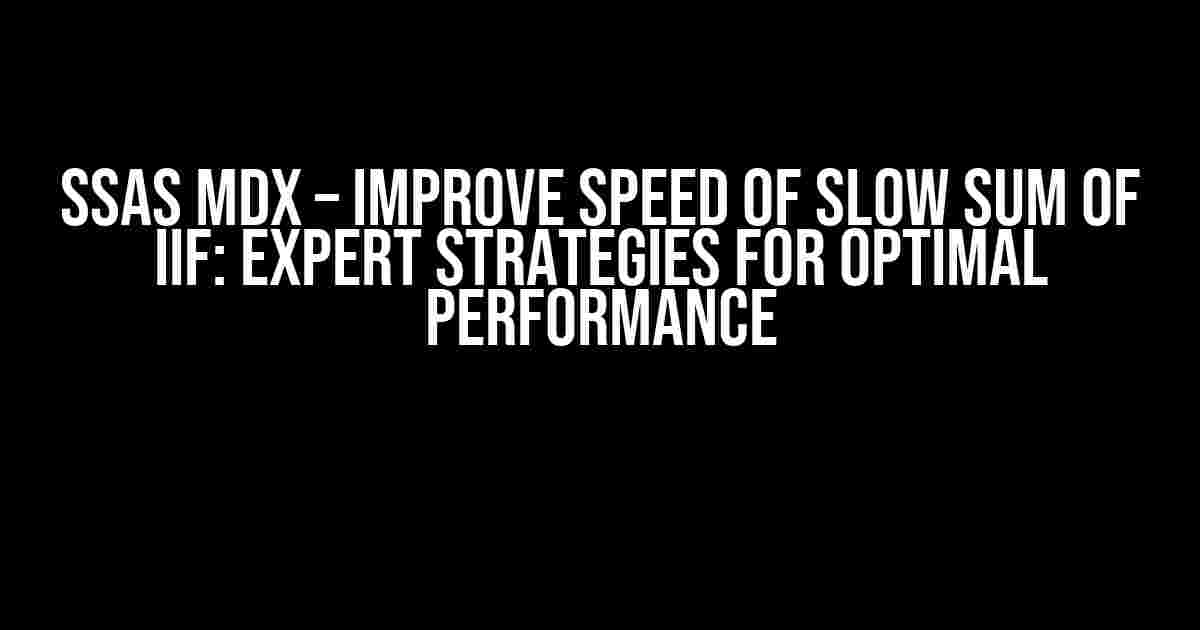Are you tired of waiting for what feels like an eternity for your SSAS MDX queries to return results? Do you find yourself stuck in a seemingly endless cycle of query optimization, only to be met with lackluster performance? Well, buckle up, friend, because we’re about to dive into the world of SSAS MDX optimization and tackle one of the most notorious performance bottlenecks: the slow SUM of IIF.
What’s the Big Deal with SUM of IIF, Anyway?
The SUM of IIF is a powerful and versatile calculation in SSAS MDX, allowing you to conditionally aggregate values based on certain criteria. It’s a staple in many reporting and analytics scenarios, particularly when dealing with complex business logic. However, this flexibility comes at a cost – performance.
The primary issue lies in the fact that IIF evaluations can be computationally expensive, especially when dealing with large datasets. When combined with the SUM aggregation function, the result can be a queries that crawl along at a snail’s pace. But don’t worry; we’re about to explore some expert strategies to improve the speed of your SUM of IIF calculations.
Optimization Strategy 1: Use EXISTS Instead of IIF
In many cases, IIF can be replaced with the EXISTS function, which can provide a significant performance boost. EXISTS is a more efficient way to check for the existence of a member or tuple in a set, making it an ideal replacement for IIF in certain scenarios.
-- Original query with IIF
SELECT
SUM(
IIF(
[Measures].[Sales Amount] > 0 AND [Geography].[Country] = "USA",
[Measures].[Sales Amount],
NULL
)
) ON COLUMNS
FROM [Adventure Works]
-- Optimized query with EXISTS
SELECT
SUM(
IIFEXISTS(
[Measures].[Sales Amount],
[Geography].[Country].members,
"USA"
)
) ON COLUMNS
FROM [Adventure Works]
By using EXISTS, we can eliminate the need for conditional evaluation and reduce the complexity of the calculation. This approach can yield significant performance improvements, especially when dealing with large datasets.
Optimization Strategy 2: Avoid Using IIF with Measures
When possible, avoid using IIF with measures, as this can lead to excessive calculations and slow performance. Instead, consider creating a derived measure or a calculated column that can be used to filter or aggregate the data.
-- Original query with IIF and measure
SELECT
SUM(
IIF(
[Measures].[Sales Amount] > 0,
[Measures].[Sales Amount],
NULL
)
) ON COLUMNS
FROM [Adventure Works]
-- Optimized query with derived measure
WITH
MEMBER [Measures].[Filtered Sales] AS
IIF(
[Measures].[Sales Amount] > 0,
[Measures].[Sales Amount],
NULL
)
SELECT
[Measures].[Filtered Sales] ON COLUMNS
FROM [Adventure Works]
By creating a derived measure or calculated column, we can reduce the complexity of the calculation and improve performance. This approach also allows for easier maintenance and reuse of the calculation.
Optimization Strategy 3: Use Non-Empty Behavior
In some cases, the slow performance of the SUM of IIF can be attributed to the Non-Empty Behavior (NEB) of the measure. NEB determines how the measure interacts with other measures and sets in the query. By adjusting the NEB, we can improve performance and reduce calculation complexity.
-- Original query with default NEB
SELECT
SUM(
IIF(
[Measures].[Sales Amount] > 0,
[Measures].[Sales Amount],
NULL
)
) ON COLUMNS
FROM [Adventure Works]
-- Optimized query with customized NEB
WITH
MEMBER [Measures].[Filtered Sales] AS
IIF(
[Measures].[Sales Amount] > 0,
[Measures].[Sales Amount],
NULL
),
NON EMPTY [Measures].[Filtered Sales]
SELECT
[Measures].[Filtered Sales] ON COLUMNS
FROM [Adventure Works]
By specifying the NON EMPTY keyword, we can ensure that only the non-empty members of the set are evaluated, reducing calculation complexity and improving performance.
Optimization Strategy 4: Leverage Data Warehouse Design
Optimizing the data warehouse design can have a significant impact on query performance. By ensuring that your fact tables are properly indexed and organized, you can reduce the amount of data that needs to be processed, leading to faster query execution times.
| Fact Table Column | Data Type | Indexing Strategy |
|---|---|---|
| Sales Amount | Decimal(18,2) | Clustered Index |
| Geography Key | Integer | Non-Clustered Index |
By creating a clustered index on the Sales Amount column and a non-clustered index on the Geography Key column, we can improve query performance and reduce the amount of data that needs to be processed.
Optimization Strategy 5: Optimize Aggregation Design
The aggregation design of your SSAS cube can also impact query performance. By optimizing the aggregation design, you can reduce the amount of data that needs to be processed and improve query execution times.
-- Original aggregation design
CREATE AGGREGATION TABLE FOR [Adventure Works]
(
[Measures].[Sales Amount]
)
-- Optimized aggregation design
CREATE AGGREGATION TABLE FOR [Adventure Works]
(
[Measures].[Sales Amount],
[Geography].[Country]
)
By including the Geography hierarchy in the aggregation design, we can reduce the amount of data that needs to be processed and improve query performance.
Conclusion
In this article, we’ve explored five expert strategies to improve the speed of slow SUM of IIF calculations in SSAS MDX. By applying these strategies, you can optimize your queries, improve performance, and get the most out of your SSAS investment.
Remember, query optimization is an iterative process that requires patience, persistence, and a deep understanding of the underlying data and query mechanics. By combining these expert strategies with a solid understanding of SSAS MDX, you’ll be well on your way to creating high-performance queries that deliver fast and accurate results.
Best Practices for SSAS MDX Query Optimization
To ensure optimal performance, follow these best practices for SSAS MDX query optimization:
- Use efficient calculation logic and avoid complex conditional statements.
- Optimize data warehouse design for fast query execution.
- Leverage aggregation design to reduce data processing.
- Use derived measures and calculated columns to simplify calculations.
- Monitor query performance and adjust optimization strategies as needed.
By following these best practices and applying the expert strategies outlined in this article, you’ll be well on your way to creating high-performance SSAS MDX queries that deliver fast and accurate results.
Final Thoughts
SSAS MDX is a powerful tool for business intelligence and analytics, but it requires careful attention to optimization to achieve optimal performance. By applying the strategies outlined in this article, you can improve the speed of slow SUM of IIF calculations and get the most out of your SSAS investment.
Remember, query optimization is an ongoing process that requires continuous monitoring and improvement. By staying up-to-date with the latest best practices and optimization strategies, you’ll be able to ensure fast and accurate results for your business intelligence and analytics applications.
Thanks for reading, and happy optimizing!
Frequently Asked Question
Are you tired of waiting for what feels like an eternity for your SSAS MDX queries to return? Do slow SUM of IIF statements have you pulling your hair out? Fear not, dear developer, for we have the answers to your most pressing questions!
What is the main reason behind slow SUM of IIF statements in SSAS MDX?
The primary culprit behind slow SUM of IIF statements is the row-by-row evaluation of the IIF function, which can lead to poor performance. This is because the IIF function is not optimized for set-based operations, causing the query to slow down significantly.
How can I improve the performance of SUM of IIF statements by reducing the number of evaluations?
One way to reduce the number of evaluations is to use a calculated measure instead of the IIF function. By defining a calculated measure that only evaluates the conditions once, you can significantly improve performance. Additionally, you can use the EXISTS or NONEMPTY functions to filter out empty cells, reducing the number of evaluations even further.
Can I use caching to improve the performance of SUM of IIF statements?
Yes, caching can be a great way to improve performance! By caching the results of the IIF statement, you can reduce the number of evaluations and speed up the query. You can use the CacheValidFor property to specify how long the cache should be valid, ensuring that the cached results are up-to-date.
How can I optimize the SUM of IIF statements by rewriting the query?
One way to optimize the query is to rewrite it using a more set-based approach. Instead of using IIF statements, try using the FILTER function to filter out the desired values and then sum them up. This can lead to significant performance improvements, especially for large datasets.
What are some other optimization techniques I can use to improve the performance of SUM of IIF statements?
Some other optimization techniques you can use include using materialized views, aggregating data at a higher level, and using data optimization techniques such as data aggregation and data summarization. Additionally, you can use indexing and partitioning to improve query performance. By combining these techniques, you can significantly improve the performance of your SUM of IIF statements.
I hope these questions and answers have helped you optimize your SUM of IIF statements and breathe a sigh of relief!


